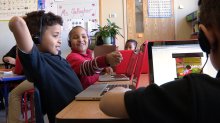Building a Community of Learners—and Citizens
A high-needs school in Rhode Island helps close the achievement gap while preparing students for active citizenship.
Your content has been saved!
Go to My Saved Content.From the primary grades through high school graduation, the 630 students of Highlander Charter School in Providence, Rhode Island, build their confidence to speak up and speak out.
Founded in 2000 as the state’s first independent public charter school, Highlander was named after the Highlander Folk School in Tennessee, a historic institution that has served as a training ground for grassroots activists—including Rosa Parks and Martin Luther King Jr.—since the earliest days of the civil rights movement.
Closing the achievement gap for the high-needs, predominantly minority student body is a priority here, and an emphasis on student engagement and social activism “teaches students to have a voice and make a difference,” says Head of School Rose Mary Grant.
“Education is the civil rights issue of our own time—especially for children living in poverty or subjected to inferior education,” says Grant. “We want to level the playing field [at Highlander] and provide access to equitable and excellent education [for all our students].”
At the school, teachers provide individualized, differentiated instruction to help each student reach his or her potential. In coursework from kindergarten through high school, students are pushed to understand others’ experiences and points of view and to advocate for their own beliefs.
Equally important is preparing students for active citizenship. Highlander’s students are made to feel connected to and part of a community through opportunities to engage in real-world projects that can lead to civic action, such as testifying about school funding or campaigning for animal rights.
Highlander Charter School
Enrollment
520 | Charter, UrbanPer Pupil Expenditures
$17049 School • $15923 StateFree / Reduced Lunch
76%DEMOGRAPHICS:
There’s plenty of evidence to show that Highlander’s strategies are working.
Students typically outperform the state average in key disciplines, helping close the achievement gap for students of color, English language learners (ELLs), and students with disabilities. In 2015, for example, students in four groups outperformed their same-group peers across the state in math: ELLs by 110 percent; African American students by 125 percent; students with disabilities by 192 percent; and low-income students by 35 percent.
Building an Inclusive Culture From the Ground Up
Highlander’s inclusive culture is no accident and starts in the classrooms of its earliest students.
One deliberate culture-building strategy is the morning meeting. Every elementary class at the school begins the day with a 15-minute circle time that helps children transition to school and feel “ready to learn.”
Based on the Responsive Classroom model, morning meetings center around peer-to-peer greetings, sharing, a fun activity, and a review of the day’s schedule. During greetings, students choose how to greet their peers—with a handshake, a high five, or a wave—and are invited to talk about what’s on their minds.
“Before any learning can take place, students need to feel safe and feel like they are seen and cared about,” said Valerie Gallagher, a first-grade teacher at the school. “The real impact of morning meeting is that classes [become] true communities, where we’re learning from each other’s strengths and we’re helping each other.”
Helping Every Student Thrive
In elementary classes, a model of differentiation called station rotation allows children to learn for 20 minutes at time in at least three different modes. As they move from station to station in small groups, they might watch online videos, create a hands-on activity, or take part in teacher-led discussions. Teachers adjust activities and groupings based on children’s readiness to stretch, or their need for support.
“Being able to move through those stations, it’s just another level of helping the students learn as much as they can each year,” said Jane Piccotti, the assistant principal. “They definitely feel excited when they make that growth.”
Personalization continues into middle school and high school with more emphasis on blended learning. Each Highlander middle schooler, for example, spends one period a day in a blended classroom, where teachers support individualized online learning. Teachers create activities and playlists tailored to each student’s needs and proficiencies, and personal dashboards track an individual’s growth and areas for improvement.
Taking a Stand
By high school, students shaped by this supportive environment have the academic mindset to dig into controversial topics. Highlander added the high school—on a separate campus—in 2013 to continue students’ “work on social justice beyond K–8.”
In Soljane Martinez’s civics class, 12th graders engage in discussions about difficult hot-button social and political topics like immigration and rights for lesbian, gay, bisexual, and transgender people. Students take sides on issues, conducting research that helps inform arguments and positions they’ll use in classroom debates with their peers.
Martinez says she challenges students to consider perspectives different from their own as they learn to support their opinions and beliefs.
“At Highlander, we want students to be able to look at something critically,” said Jessica Blanco, the assistant head of school. “They need to know how to advocate for themselves, but they also know they have to take in various perspectives.”
Highlander is a good reminder that activism can lead to meaningful results.
A former student of Martinez’s named Domingo was among the high school’s first graduates last June. He credits Martinez and his Highlander experience with preparing him to tackle whatever challenges await next.
“We live in a world where people feel it’s acceptable to just look at your skin and believe who you are,” Domingo said, reflecting on Martinez’s class. “For me to see that somebody was just like me and able to succeed—she has inspired me to be a better person, to believe that I can do anything I want.”
